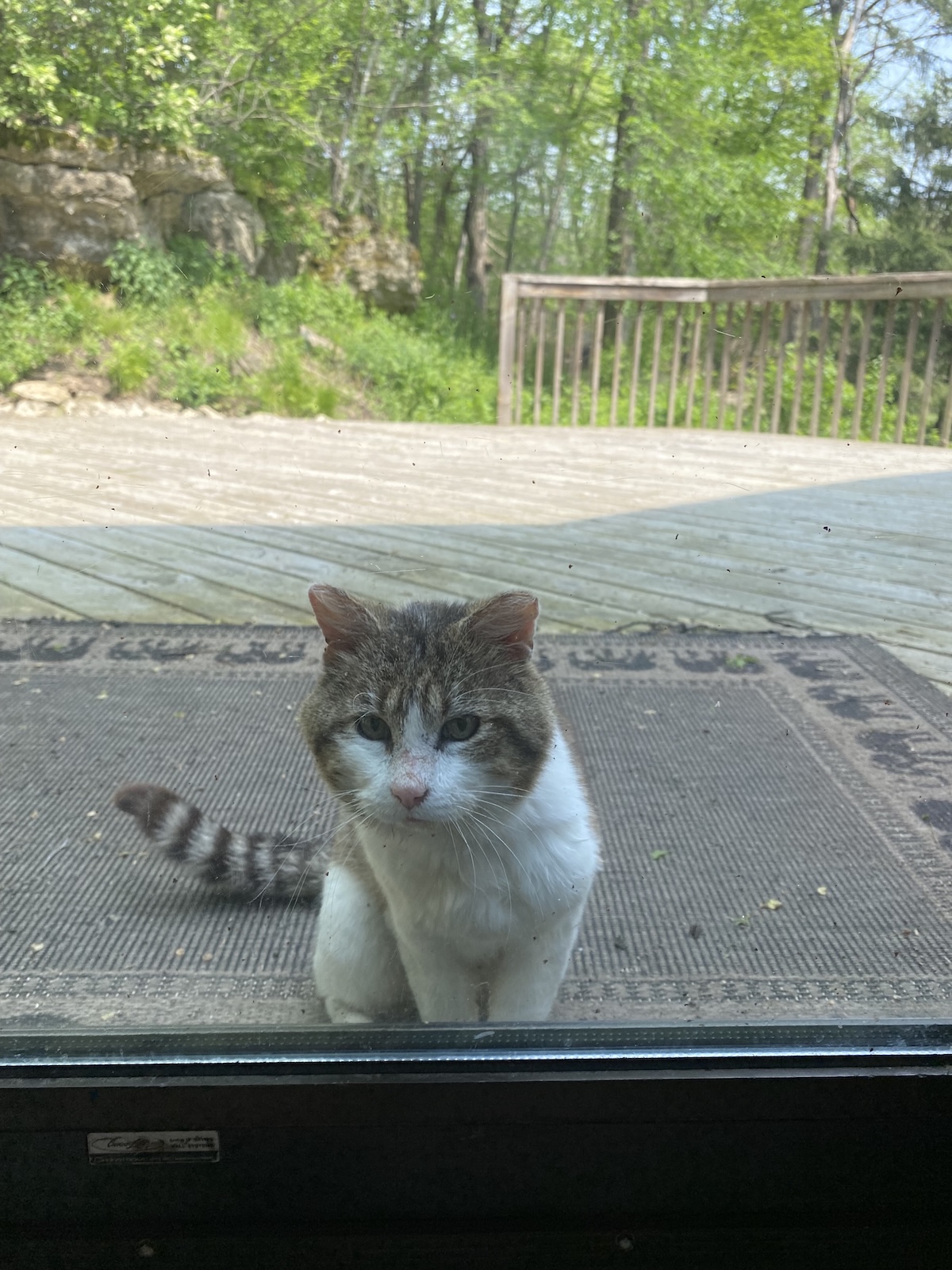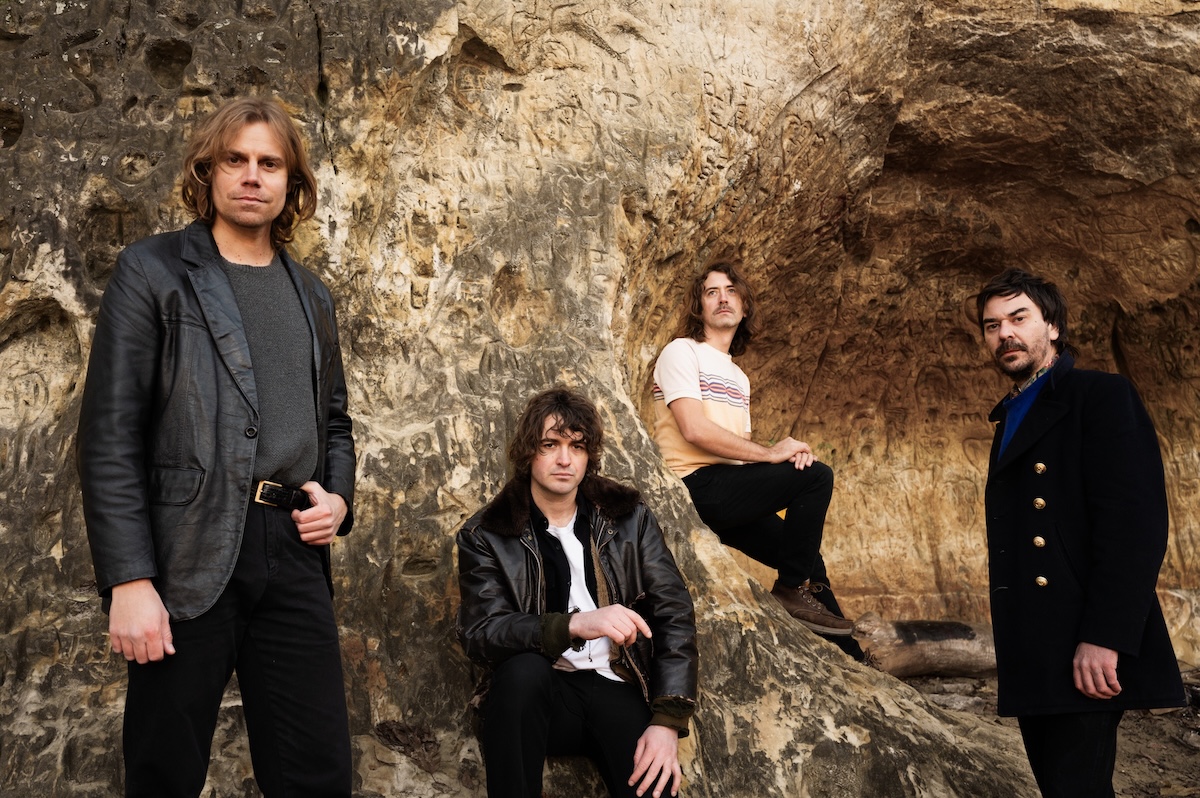“What’s crazy is we had two different sessions at Pachyderm. And each time the power went out, which we already thought was really weird. In fact, the guy who runs the studio, Nick [Tveitbakk], said that never happened in 15 years,” John Pelant explained, while sitting on a lawn chair from the safety of his Midwest backyard. The frontman of Minneapolis indie rockers Night Moves and his bandmates (Micky Alfano, Mark Hanson, and Charles Murlowski) had just hunkered down at the famed Midwest sonic playground to begin a second session for their latest album for the Domino label, Double Life, when a curious feline showed up out of nowhere on a pitch-black night.
“The really strange thing about the second time, though, was that this cat suddenly appeared outside. … We started hearing this meowing. It was probably 11 at night and pitch-black outside because we were in the country with no power and here was this cat. The nearest neighbor is, like, miles away. … As Nick also told us, they don’t get strays. … So we were like, this is crazy. I mean there are so many horror movies based on that type of [scenario].”
Pelant had heard of the supposed haunted lore of Pachyderm for years but had never experienced it firsthand. It wasn’t the first time Night Moves—formed in 2010 over a love of Gram Parsons, Glen Campbell, and Panda Bear—had recorded at the spot, either. The most recent was in 2021 when they laid down new tracks, including the psychedelic cowboy single “Fallacy Actually.” But everything then was status quo.
The studio, located in a remote part of Minnesota called Cannon Falls, about 45 minutes from the Twin Cities, has been the breeding ground for a litany of important rock albums, not the least of which is Nirvana’s final record, In Utero, in 1993. But it was also ground zero for Failure’s 1992 album Comfort, PJ Harvey’s 1993 opus Rid of Me, and Live’s Throwing Copper the following year. Through the 2000s, Pachyderm also was the go-to recording spot for Alkaline Trio, Andrew Bird, and Trampled by Turtles, among others.
A unique thing about the property is that there’s an adjacent midcentury house where many bands stay (there’s photos of a young Frances Bean Cobain near the great room’s fireplace when Nirvana set up camp). It was built in 1963 by Herb Bloomberg, who was inspired by the architecture of Frank Lloyd Wright. Inside the 5,500-square-foot house, there’s a kidney-shaped pool, spiral staircases, and second-story screened gazebo. Outside, Pine Creek runs behind the house, where some bands have fished between sessions. Pelant compared it to something out of The Shining, recalling that even before the arrival of the cat—who they eventually named Loomis—there were other strange things happening inside, like doorknobs and handles twisting on their own. “I remember I was just sitting at the table and I heard a door behind me slam. I looked back thinking I would see somebody, but there was no one. It just felt so strange. And I was like, okay, now I’m hearing the ghost that everyone has talked about.”
The sprawling property has traded hands a number of times over the years, most recently in 2011 when it was acquired by engineer John Kuker. He brought it back from a state of disarray into the revived musical landmark it is today. Sadly Kuker passed away in 2015. But here’s the really interesting part as it relates to this story: Kuker died right before Night Moves was to record their 2016 album Pennied Days at Pachyderm.

“I don’t think I ever told Night Moves this, but that cat had once appeared on John Kuker’s birthday,” Tveitbakk said, when reached by phone. While the engineer-producer noted that some bands now just play pranks on each other when they find out the history, there are still so many things that can’t be explained. Minnesota Public Radio station The Current talks about a time when Nirvana was recording when, out of nowhere, an idle chair straight up flew into the pool.
Tveitbakk also recalled some less dramatic but still bizarre events. “One time I had just finished a record with a band called Yam Haus and as I was in the driveway pulling out of the studio, what came on the radio but Yam Haus,” he shared. “Or there’s times I’ll think something on the drive down [to Pachyderm] and someone later in the day says what I’m thinking. … They’re examples of things that happen almost every day here. It blows my mind all the time trying to figure out how is this possible and how is this stuff happening every day? But there’s something to the land down there that is pretty mystical and amazing and really helps people create things.”
The studio’s name, Pachyderm, refers to a history of the region that goes back to the time of the Ice Age. Cannon Falls, Minnesota, sits in an interesting pocket of America referred to as the Driftless Area that runs through Minnesota, Wisconsin, and Iowa, where glaciers came through, flattened everything, and changed the landscape some 20,000 years ago. “So you have all these ancient valleys cut even deeper from the run off of the glacier melting, which is also the Mississippi River and Lake Pepin and all these areas that are very close to Pachyderm,” explained Tveitbakk.

“I describe [what’s happening] as ancient energy. Some people take it as hauntings … but there’s an interesting unknown supernatural thing going on here, there’s no doubt in my mind,” he said, adding, “But there are a lot of studios across America that have a vibe or whatever you want to call it that just emanates out of the property and that helps make cool records. … When the right people like Night Moves come … they can tap into whatever that is and that just helps them create amazing music.”
Pelant admitted that while he loves horror movies and a good ghost story, he can be pretty cynical about the supernatural at times. It may stem from his background in anthropology, where there always seems to be scientific answers about humankind. Pelant studied the subject at the University of Wisconsin-Milwaukee and the University of Minnesota, eventually earning a bachelor’s degree. “I definitely can be closed off … but I think this go-around, I was a little more open to [the supernatural],” he shared. “And things just kept happening that were weird.”
Before making Double Life, Night Moves’ first album in six years, he had taken an odd job as a delivery driver for a distributor selling wine and spirits. Next to the warehouse where he’d pick up packages was another warehouse that sold funeral supplies. “I was thinking a lot about how I’m selling booze and how booze kills you (even though I’m a drinker). And I was just like, you know, if you don’t cool it, I’m probably going to have a visit from these guys. That was just my own morbidity coming out from the place I was in.”

As he was writing songs like the moody rambler “State Sponsored Psychosis” and the piano plea “Desperation,” it also came around the time the band was dealing with a number of unfortunate personal events. According to the bio, there was “the unexpected death of a father-in-law, then a drummer whose skin sloughed off during recording due to contact dermatitis. There were friends arrested for making mistakes in troubled times and assorted pals struggling with sobriety and sanity.”
As Pelant shared, “I was thinking about the fragility of life and how you see people come and go and people getting sick or fall into addictions and there’s suicides and stuff going on in your orbit. I think I was just, maybe, thinking more about, like, death and the fragility of life and how maybe, if you’re not careful, you can end up like these people. … It felt apropos to put that into the music.” As he added, the band didn’t really know what the album would become in the end.
But as they came up with the idea for Double Life, “it just felt like it was a good title for the 11 songs that we had put together,” said Pelant. As it was, the title wrapped together all the feelings ruminating within about past lives, future lives, reincarnation, and the transfer of energy. All of it undoubtedly symbolic of Loomis’ arrival as Night Moves worked—so much so, that the cat became the album’s unofficial mascot.
“There’s a time and a place to be open and receptive to [the supernatural],” Pelant concluded. “In creating something like music or art and writing lyrics and songs, I think you do have to kind of always sort of have an openness and or be receptive to the other spirit world. I do now.”
The story of Loomis also has a happy ending. During the remainder of the recording sessions, Night Moves and Tveitbakk made a home for the cat outside and left food and water. They eventually brought him to a local animal hospital who cleaned him up and took him to a shelter a few towns away where he was eventually adopted. Now, said Tveitbakk, “Loomis is living a happy life of retirement outside the woods.”
Catch Night Moves on tour through November 7—find more info at https://nightmovesmpls.com/#
Horror Show is a new series uncovering the stories of artists’ experiences with the supernatural, paranormal, and unexplained—and how surviving it provided new appreciation for creating in the here and now.



